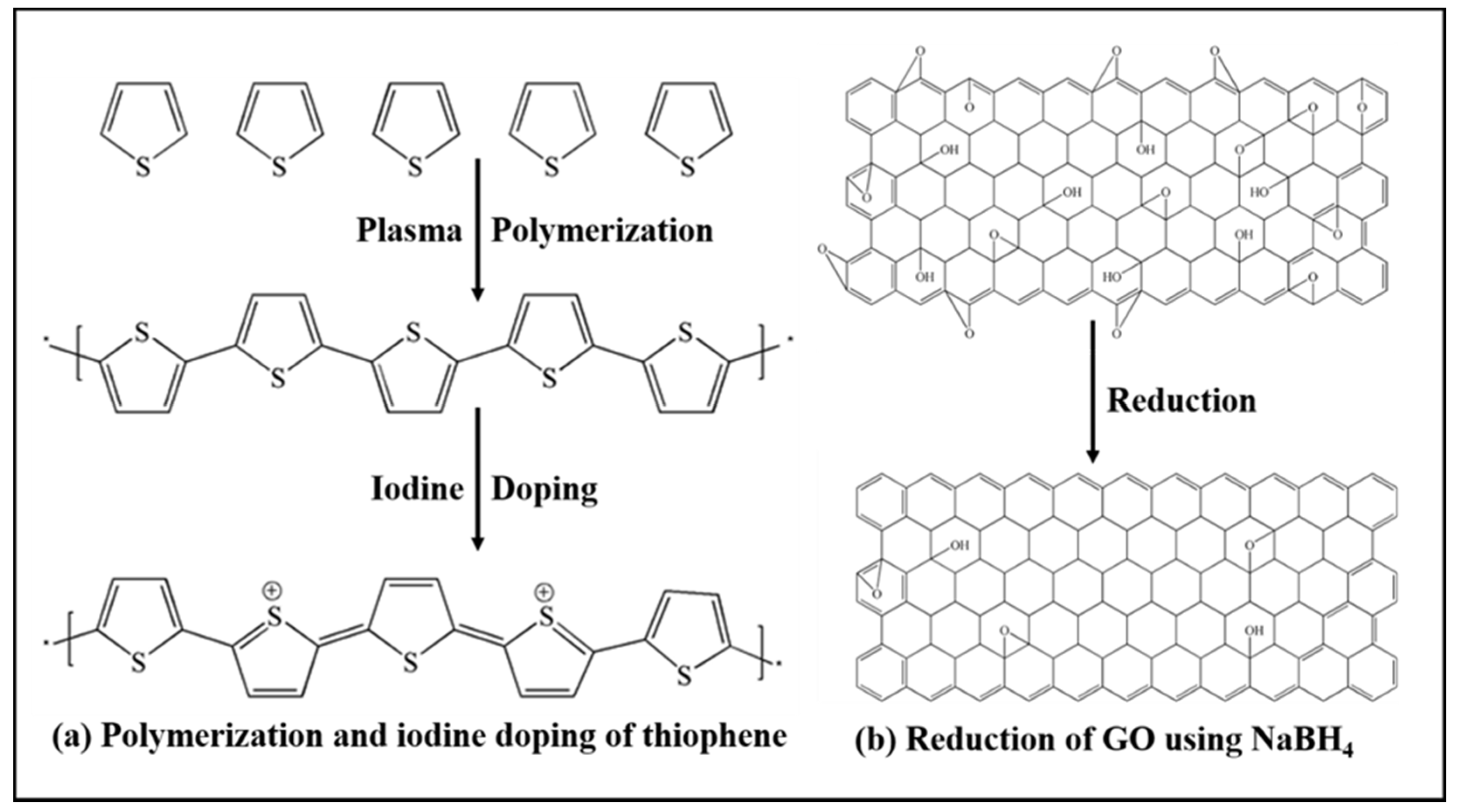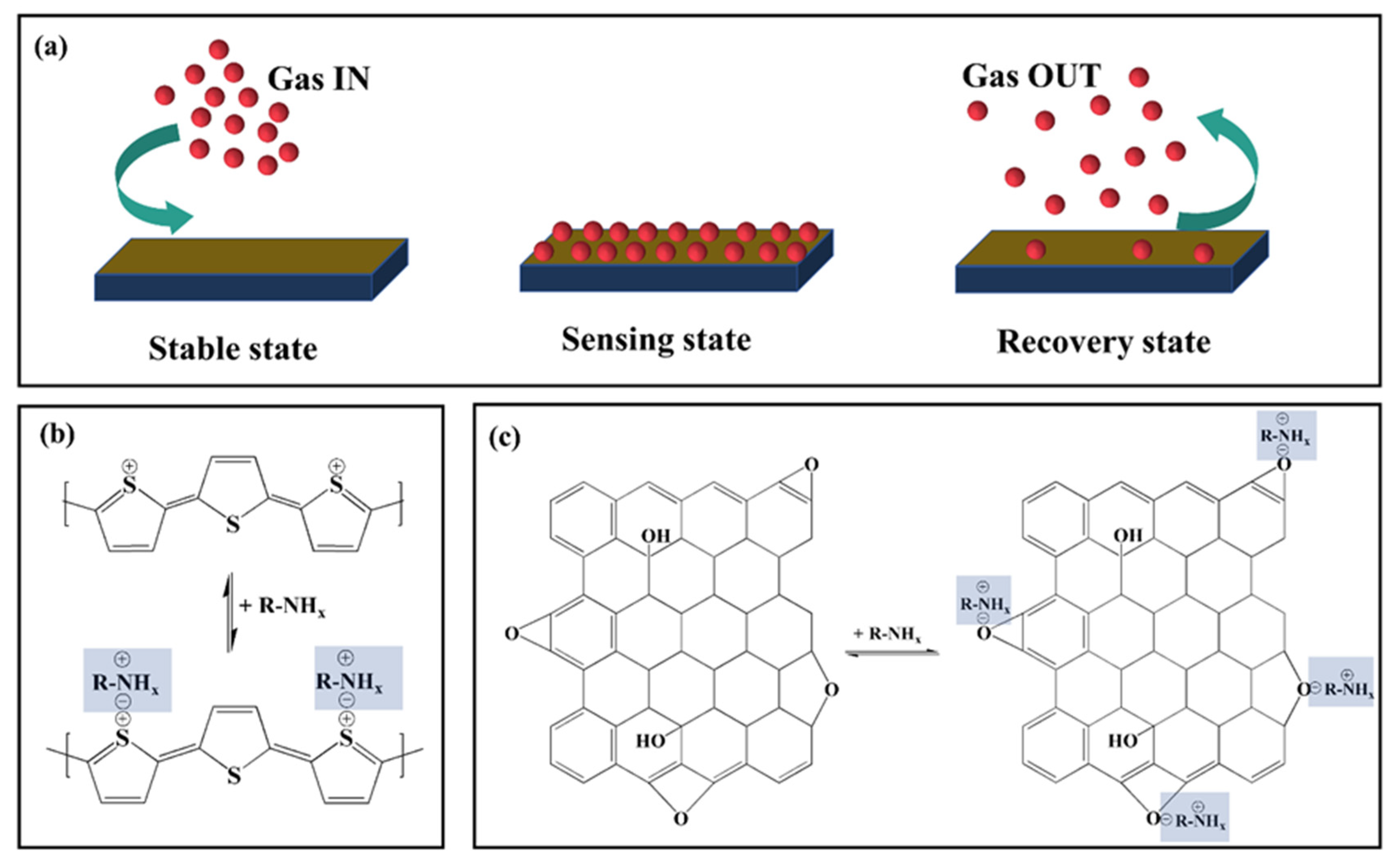Plasma-Polymerized Thiophene-Reduced Graphene Oxide Composite Film Sensor for Ammonia/Amine Detection at Room Temperature
Abstract
1. Introduction
2. Materials and Methods
2.1. Materials and Chemicals
2.2. PPTh Polymerization, rGO Synthesis, and Composite PVAc-rGO
2.3. Structural, Chemical, and Morphological Studies
2.4. Ammonia/Amine Sensing Characteristics
3. Results and Discussion
3.1. Structural Analysis
3.2. FTIR Analysis
3.3. Morphological Analysis
3.4. Ammonia/Amine Sensing Studies
3.4.1. Sensitivities of PPTh, rGO, and Composite PPTh-rGO Films
3.4.2. Repeatability, Response-Recovery Time, and Selectivity
3.4.3. Stability of PPTh-rGO Composite Films under Varying Temperatures, Varied Relative Humidity, and over Long Durations
3.4.4. Ammonia/Amine Sensing Mechanism
4. Conclusions
Supplementary Materials
Author Contributions
Funding
Institutional Review Board Statement
Informed Consent Statement
Data Availability Statement
Conflicts of Interest
References
- Jiang, Y.; Huang, J.; Wang, W.; Hunger, M. Formation of methylamines by the reaction of ammonia with surface methoxy species on zeolite H-Y and the silicoaluminophosphate H-SAPO-34. In Studies in Surface Science and Catalysis; Elsevier: Amsterdam, The Netherlands, 2007; pp. 1331–1337. [Google Scholar]
- Andre, R.S.; Mercante, L.A.; Facure, M.H.M.; Sanfelice, R.C.; Fugikawa-Santos, L.; Swager, T.M.; Correa, D.S. Recent progress in amine gas sensors for food quality monitoring: Novel architectures for sensing materials and systems. ACS Sens. 2022, 7, 2104–2131. [Google Scholar] [CrossRef] [PubMed]
- Zhang, Y.; Peng, C.; Ma, X.; Che, Y.; Zhao, J. Fluorescent and photoconductive nanoribbons as a dual-mode sensor for selective discrimination of alkyl amines versus aromatic amines. Chem. Commun. 2015, 51, 15004–15007. [Google Scholar] [CrossRef] [PubMed]
- Vasconcelos, H.; Coelho, L.C.C.; Matias, A.; Saraiva, C.; Jorge, P.A.S.; de Almeida, J.M.M.M. Biosensors for biogenic amines: A review. Biosensors 2021, 11, 82. [Google Scholar] [CrossRef] [PubMed]
- Dhall, S.; Mehta, B.R.; Tyagi, A.K.; Sood, K. A review on environmental gas sensors: Materials and technologies. Sens. Int. 2021, 2, 100116. [Google Scholar] [CrossRef]
- Bai, H.; Shi, G. Gas sensors based on conducting polymers. Sensors 2007, 7, 267–307. [Google Scholar] [CrossRef]
- Kawata, K. Development of mass-production-type plasma chemical vapour deposition equipment and its application to various dies. Surf. Coat. Technol. 1992, 54–55, 604–608. [Google Scholar] [CrossRef]
- Lawal, A.T. Graphene-based nano composites and their applications. A review. Biosens. Bioelectron. 2019, 141, 111384. [Google Scholar] [CrossRef]
- Bianco, A.; Cheng, H.-M.; Enoki, T.; Gogotsi, Y.; Hurt, R.H.; Koratkar, N.; Kyotani, T.; Monthioux, M.; Park, C.R.; Tascon, J.M.D.; et al. All in the graphene family—A recommended nomenclature for two-dimensional carbon materials. Carbon N. Y. 2013, 65, 1–6. [Google Scholar] [CrossRef]
- Li, B.; Santhanam, S.; Schultz, L.; Jeffries-EL, M.; Iovu, M.C.; Sauvé, G.; Cooper, J.; Zhang, R.; Revelli, J.C.; Kusne, A.G.; et al. Inkjet printed chemical sensor array based on polythiophene conductive polymers. Sens. Actuators B Chem. 2007, 123, 651–660. [Google Scholar] [CrossRef]
- Gonçalves, V.C.; Balogh, D.T. Optical chemical sensors using polythiophene derivatives as active layer for detection of volatile organic compounds. Sens. Actuators B Chem. 2012, 162, 307–312. [Google Scholar] [CrossRef]
- Park, C.-S.; Kim, D.Y.; Jung, E.Y.; Jang, H.J.; Bae, G.T.; Kim, J.Y.; Shin, B.J.; Lee, H.-K.; Tae, H.-S. Ultrafast Room temperature synthesis of porous polythiophene via atmospheric pressure plasma polymerization technique and its application to NO2 gas sensors. Polymers 2021, 13, 1783. [Google Scholar] [CrossRef] [PubMed]
- Zhang, R.; Wang, Y.; Li, J.; Zhao, H.; Wang, Y.; Zhou, Y. Mesoporous cellulose nanofibers-interlaced PEDOT:PSS hybrids for chemiresistive ammonia detection. Microchim. Acta 2022, 189, 308. [Google Scholar] [CrossRef] [PubMed]
- Martin, L.; Esteve, J.; Borrós, S. Growth vs. nucleation of conducting polymers thin films obtained by plasma-enhanced chemical vapor deposition. Thin Solid Films 2004, 451–452, 74–80. [Google Scholar] [CrossRef]
- Groenewoud, L.M.H.; Engbers, G.H.M.; White, R.; Feijen, J. On the iodine doping process of plasma polymerised thiophene layers. Synth. Met. 2001, 125, 429–440. [Google Scholar] [CrossRef]
- Geim, A.K.; Novoselov, K.S. The rise of graphene. Nat. Mater. 2007, 6, 183–191. [Google Scholar] [CrossRef]
- Singh, S.A.; More, P.S.; Khollam, Y.B.; Kondawar, S.B. Enhanced Hydrogen gas sensing characteristics of graphene modified with rubidium (Rb). Mater. Chem. Phys. 2021, 260, 124105. [Google Scholar] [CrossRef]
- Mbayachi, V.B.; Ndayiragije, E.; Sammani, T.; Taj, S.; Mbuta, E.R.; Khan, A.U. Graphene synthesis, characterization and its applications: A review. Results Chem. 2021, 3, 100163. [Google Scholar] [CrossRef]
- Madurani, K.A.; Suprapto, S.; Machrita, N.I.; Bahar, S.L.; Illiya, W.; Kurniawan, F. Progress in graphene synthesis and its application: History, challenge and the future outlook for research and industry. ECS J. Solid State Sci. Technol. 2020, 9, 093013. [Google Scholar] [CrossRef]
- Smith, A.T.; LaChance, A.M.; Zeng, S.; Liu, B.; Sun, L. Synthesis, properties, and applications of graphene oxide/reduced graphene oxide and their nanocomposites. Nano Mater. Sci. 2019, 1, 31–47. [Google Scholar] [CrossRef]
- Singh, S.A.; More, P.S.; Late, D.J.; Raut, R.W. Investigation of PEG embedded WO3-graphene thin film sensor. Adv. Mater. Proc. 2021, 2, 506–509. [Google Scholar] [CrossRef][Green Version]
- More, P.S.; Khollam, Y.B.; Koinkar, P.; Sali, N.D.; Shelke, P.N.; Borwar, S.S. Polyethylene oxide- Cu-composite thick films for lpg sensing. Int. J. Mod. Phys. B 2011, 25, 4199–4203. [Google Scholar] [CrossRef]
- Ben Ishay, R.; Harel, Y.; Lavi, R.; Lellouche, J.-P. Multiple functionalization of tungsten disulfide inorganic nanotubes by covalently grafted conductive polythiophenes. RSC Adv. 2016, 6, 89585–89598. [Google Scholar] [CrossRef]
- Golsheikh, A.M.; Huang, N.M.; Lim, H.N.; Zakaria, R. One-pot sonochemical synthesis of reduced graphene oxide uniformly decorated with ultrafine silver nanoparticles for non-enzymatic detection of H2O2 and optical detection of mercury ions. RSC Adv. 2014, 4, 36401–36411. [Google Scholar] [CrossRef]
- Singh, R.; Bajpai, A.K.; Shrivastava, A.K. CdSe nanorod-reinforced Poly(Thiophene) composites in designing energy storage devices: Study of morphology and dielectric behavior. Polym. Bull. 2021, 78, 115–131. [Google Scholar] [CrossRef]
- Gund, G.S.; Dubal, D.P.; Jambure, S.B.; Shinde, S.S.; Lokhande, C.D. Temperature influence on morphological progress of Ni(OH)2 thin films and its subsequent effect on electrochemical supercapacitive properties. J. Mater. Chem. A Mater. 2013, 1, 4793. [Google Scholar] [CrossRef]
- Zhao, Y.-F.; Sun, Y.-P.; Yin, X.; Yin, G.-C.; Wang, X.-M.; Jia, F.-C.; Liu, B. Effect of surfactants on the microstructures of hierarchical sno2 blooming nanoflowers and their gas-sensing properties. Nanoscale Res. Lett. 2018, 13, 250. [Google Scholar] [CrossRef] [PubMed]
- Jeevitha, G.; Abhinayaa, R.; Mangalaraj, D.; Ponpandian, N.; Meena, P.; Mounasamy, V.; Madanagurusamy, S. Porous reduced graphene oxide (RGO)/WO3 nanocomposites for the enhanced detection of NH3 at room temperature. Nanoscale Adv. 2019, 1, 1799–1811. [Google Scholar] [CrossRef]
- Wankhede, Y.B.; Kondawar, S.B.; Thakare, S.R.; More, P.S. Synthesis and characterization of silver nanoparticles embedded in polyaniline nanocomposite. Adv. Mater. Lett. 2013, 4, 89–93. [Google Scholar] [CrossRef]
- Potdar, R.P.; Khollam, Y.B.; Shaikh, S.F.; More, P.S.; Rana, A.U.H.S. Polyvinylpyrrolidone-capped silver nanoparticles for highly sensitive and selective optical fiber-based ammonium sensor. Nanomaterials 2022, 12, 3373. [Google Scholar] [CrossRef]
- Postica, V.; Lupan, O.; Gapeeva, A.; Hansen, L.; Khaledialidusti, R.; Mishra, A.K.; Drewes, J.; Kersten, H.; Faupel, F.; Adelung, R.; et al. Improved long-term stability and reduced humidity effect in gas sensing: SiO2 ultra-thin layered ZnO columnar films. Adv. Mater. Technol. 2021, 6, 2001137. [Google Scholar] [CrossRef]
- Sahu, P.K.; Pandey, R.K.; Dwivedi, R.; Mishra, V.N.; Prakash, R. Polymer/graphene oxide nanocomposite thin film for NO2 sensor: An in situ investigation of electronic, morphological, structural, and spectroscopic properties. Sci. Rep. 2020, 10, 2981. [Google Scholar] [CrossRef] [PubMed]
- Seekaew, Y.; Lokavee, S.; Phokharatkul, D.; Wisitsoraat, A.; Kerdcharoen, T.; Wongchoosuk, C. Low-cost and flexible printed graphene–PEDOT:PSS gas sensor for ammonia detection. Org. Electron. 2014, 15, 2971–2981. [Google Scholar] [CrossRef]
- Wang, X.; Yong, Y.; Yang, W.; Zhang, A.; Xie, X.; Zhu, P.; Kuang, Y. Adsorption, gas-sensing, and optical properties of molecules on a diazine monolayer: A first-principles study. ACS Omega 2021, 6, 11418–11426. [Google Scholar] [CrossRef] [PubMed]
- Gupta, M.; Hawari, H.F.; Kumar, P.; Burhanudin, Z.A.; Tansu, N. Functionalized reduced graphene oxide thin films for ultrahigh CO2 gas sensing performance at room temperature. Nanomaterials 2021, 11, 623. [Google Scholar] [CrossRef] [PubMed]
- Drewniak, S.; Procek, M.; Muzyka, R.; Pustelny, T. Comparison of gas sensing properties of reduced graphene oxide obtained by two different methods. Sensors 2020, 20, 3175. [Google Scholar] [CrossRef] [PubMed]







| Sr. No. | Sample Name | Frequency | Duty Cycle | Total Deposition Time |
|---|---|---|---|---|
| 1 | PT1 | 10 Hz | 50% | 5 min |
| 2 | PT2 | 10 Hz | 10% | 5 min |
| 3 | PT3 | 20 Hz | 50% | 5 min |
| 4 | PT4 | 20 Hz | 10% | 5 min |
| Sr. No. | Composite Sample Name | PPTh Sample Used | rGO Concentration (in DI Water) |
|---|---|---|---|
| 1 | PT2G1 | PT2 | 0.01 g/50 mL |
| 2 | PT2G2 | PT2 | 0.1 g/50 mL |
| 3 | PT2G3 | PT2 | 1.0 g/50 mL |
| 4 | PT2G4 | PT2 | 10 g/50 mL |
| Sr. No. | Composite Sample Name | PPTh Sample Used | rGO Concentration (in DI Water) |
|---|---|---|---|
| 1 | PT1G3 | PT1 | 1.0 g/50 mL |
| 2 | PT2G3 | PT2 | 1.0 g/50 mL |
| 3 | PT3G3 | PT3 | 1.0 g/50 mL |
| 4 | PT4G3 | PT4 | 1.0 g/50 mL |
| Sensing Material | Synthesis Method | Analyte Gas | Sensitivity | Selectivity | Response/Recovery Time | Reference |
|---|---|---|---|---|---|---|
| Polythiophene | Chemical synthesis | Methanol—1000 ppm | 6.39 | ~3 | ~100 s/100 s | [10] |
| Polythiophene and its derivatives | Oxidative polymerization | Toluene—1000 ppm | 42 | ~8 | ~100 s/400 s | [11] |
| Polythiophene | Plasma Polymerization | NO2—1 ppm | 73 | NA | 1000 s/5000 s | [12] |
| Functionalized rGO | Chemical synthesis | CO2—500 ppm | 210 | NA | 60 s/60 s | [35] |
| rGO | Hummers/Tour’s method | Hydrogen—4% | 50 | NA | ~2000 s/1000 s | [36] |
| PPTh-rGO | Plasma polymerization/Ultrasonic spray deposition | Methylamine—1000 ppm | 2354 | 110 | 380 s/60 s | Present work |
| PPTh-rGO | Plasma polymerization/Ultrasonic spray deposition | Ammonia—1000 ppm | 2082 | 97 | 380 s/60 s | Present work |
| PPTh-rGO | Plasma polymerization/Ultrasonic spray deposition | Dimethylamine—1000 ppm | 1823 | 85 | 380 s/60 s | Present work |
| PPTh-rGO | Plasma polymerization/Ultrasonic spray deposition | Trimethylamine—1000 ppm | 1328 | 62 | 380 s/60 s | Present work |
Disclaimer/Publisher’s Note: The statements, opinions and data contained in all publications are solely those of the individual author(s) and contributor(s) and not of MDPI and/or the editor(s). MDPI and/or the editor(s) disclaim responsibility for any injury to people or property resulting from any ideas, methods, instructions or products referred to in the content. |
© 2023 by the authors. Licensee MDPI, Basel, Switzerland. This article is an open access article distributed under the terms and conditions of the Creative Commons Attribution (CC BY) license (https://creativecommons.org/licenses/by/4.0/).
Share and Cite
Nadekar, B.; Khollam, Y.B.; Shaikh, S.F.; Trimukhe, A.; Deshmukh, R.; More, P.S.; Siddiqui, M.U.H.; Rana, A.u.H.S.; Palaniswami, M. Plasma-Polymerized Thiophene-Reduced Graphene Oxide Composite Film Sensor for Ammonia/Amine Detection at Room Temperature. Chemosensors 2023, 11, 42. https://doi.org/10.3390/chemosensors11010042
Nadekar B, Khollam YB, Shaikh SF, Trimukhe A, Deshmukh R, More PS, Siddiqui MUH, Rana AuHS, Palaniswami M. Plasma-Polymerized Thiophene-Reduced Graphene Oxide Composite Film Sensor for Ammonia/Amine Detection at Room Temperature. Chemosensors. 2023; 11(1):42. https://doi.org/10.3390/chemosensors11010042
Chicago/Turabian StyleNadekar, Baliram, Yogesh B. Khollam, Shoyebmohamad F. Shaikh, Ajinkya Trimukhe, Rajendra Deshmukh, Pravin S. More, Muhammad Usman Hassan Siddiqui, Abu ul Hassan S. Rana, and Marimuthu Palaniswami. 2023. "Plasma-Polymerized Thiophene-Reduced Graphene Oxide Composite Film Sensor for Ammonia/Amine Detection at Room Temperature" Chemosensors 11, no. 1: 42. https://doi.org/10.3390/chemosensors11010042
APA StyleNadekar, B., Khollam, Y. B., Shaikh, S. F., Trimukhe, A., Deshmukh, R., More, P. S., Siddiqui, M. U. H., Rana, A. u. H. S., & Palaniswami, M. (2023). Plasma-Polymerized Thiophene-Reduced Graphene Oxide Composite Film Sensor for Ammonia/Amine Detection at Room Temperature. Chemosensors, 11(1), 42. https://doi.org/10.3390/chemosensors11010042









